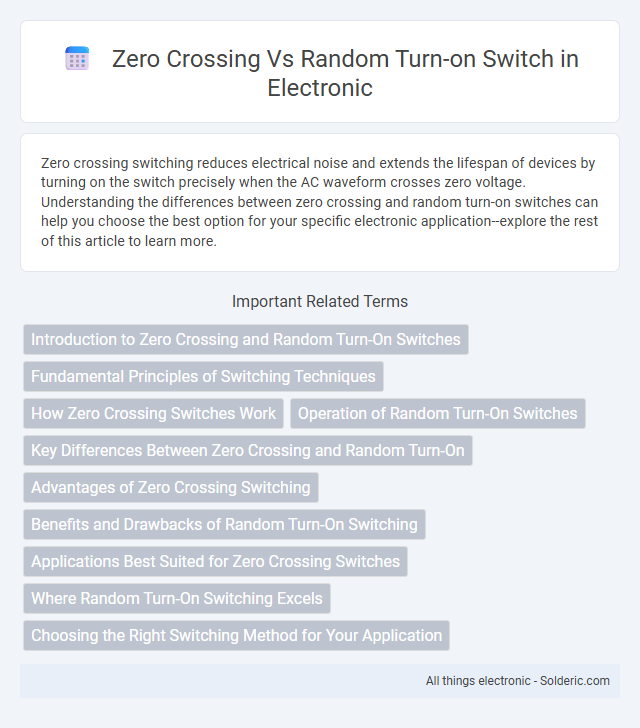Zero crossing switching reduces electrical noise and extends the lifespan of devices by turning on the switch precisely when the AC waveform crosses zero voltage. Understanding the differences between zero crossing and random turn-on switches can help you choose the best option for your specific electronic application--explore the rest of this article to learn more.
Comparison Table
| Feature | Zero Crossing Switch | Random Turn-On Switch |
|---|---|---|
| Switching Point | At AC voltage zero crossing | At any random point in the AC cycle |
| EMI (Electromagnetic Interference) | Low EMI due to minimal current surge | High EMI from voltage/current spikes |
| Load Types | Resistive & inductive | Primarily resistive; cautious with inductive |
| Noise | Less switching noise | More audible and electrical noise |
| Suitability | Ideal for dimmers, heaters, and sensitive devices | Used in simple switching with less concern for noise |
| Complexity | Requires zero-cross detection circuitry | Simpler, no zero-cross detection needed |
Introduction to Zero Crossing and Random Turn-On Switches
Zero crossing switches activate electrical loads precisely when the AC voltage waveform crosses zero volts, minimizing electrical noise and reducing electromagnetic interference in circuits. Random turn-on switches trigger at any point in the AC cycle, allowing for faster switching but potentially causing more electrical noise and stress on the components. Your choice between zero crossing and random turn-on switches impacts the efficiency, performance, and longevity of your electronic devices.
Fundamental Principles of Switching Techniques
Zero crossing switch operates by turning on the load precisely when the AC voltage waveform crosses the zero-voltage point, minimizing electrical noise and inrush current. Random turn-on switch activates at any voltage point during the AC cycle, allowing more flexible timing but resulting in higher electromagnetic interference and increased stress on electrical components. Understanding these fundamental switching principles helps you select the optimal method for balancing efficiency, load protection, and noise reduction in your application.
How Zero Crossing Switches Work
Zero crossing switches operate by detecting the point in an AC waveform where the voltage crosses zero volts, minimizing electrical noise and inrush current when turning on connected loads. By switching precisely at this zero voltage point, they reduce electromagnetic interference and extend the lifespan of electrical components. This technique is commonly used in solid-state relays and dimmers to ensure smooth and efficient power control.
Operation of Random Turn-On Switches
Random turn-on switches operate by initiating conduction at any point in the AC voltage waveform, leading to immediate current flow regardless of the instantaneous voltage level. This contrasts with zero crossing switches, which only turn on when the AC waveform passes through zero volts, minimizing inrush current and electromagnetic interference. The operation of random turn-on switches allows faster switching response but can cause higher electrical noise and stress on the circuit components.
Key Differences Between Zero Crossing and Random Turn-On
Zero crossing and random turn-on are two distinct switching methods for thyristors and triacs used in AC power control. Zero crossing switches activate the device precisely when the AC voltage crosses zero volts, reducing electrical noise and minimizing electromagnetic interference, while random turn-on switches trigger the device at any point in the AC cycle, allowing more precise control of power output. Your choice between these methods impacts switching noise, power efficiency, and application suitability in dimmers, motor controls, and heating systems.
Advantages of Zero Crossing Switching
Zero crossing switching reduces electrical noise and minimizes inrush current by activating the switch precisely when the AC voltage waveform crosses zero volts. This method extends the lifespan of both the switch and connected devices by decreasing electrical stress and preventing voltage spikes. Enhanced energy efficiency and smoother operation in lighting and motor control systems result from the precise timing of zero crossing switching.
Benefits and Drawbacks of Random Turn-On Switching
Random turn-on switching offers benefits such as reduced electromagnetic interference (EMI) because it spreads the switching noise over a broader frequency range, minimizing peak emissions compared to zero crossing switches. However, drawbacks include potential increases in inrush current and stress on components, which can reduce system reliability and efficiency. Your choice should consider whether EMI reduction or component longevity is the higher priority for your application.
Applications Best Suited for Zero Crossing Switches
Zero crossing switches are best suited for applications requiring precise control of resistive loads such as incandescent lighting, electric heaters, and motor starters, where minimizing electromagnetic interference (EMI) is crucial. These switches reduce electrical noise and extend the lifespan of connected devices by switching power at the zero voltage point, preventing voltage spikes. You can improve the reliability and efficiency of your systems in industrial automation and home appliance control by choosing zero crossing switches.
Where Random Turn-On Switching Excels
Random turn-on switching excels in reducing electromagnetic interference (EMI) by distributing noise energy over a broader frequency spectrum, which minimizes peak emissions compared to zero crossing switching. It enables faster turn-on times, improving efficiency in applications requiring rapid switching transitions and dynamic load conditions. Your system benefits from enhanced noise performance and flexibility in high-frequency power conversion scenarios where zero crossing methods may introduce timing constraints.
Choosing the Right Switching Method for Your Application
Zero crossing switches activate precisely when the AC waveform crosses zero volts, minimizing electrical noise and reducing electromagnetic interference, making them ideal for sensitive electronic equipment and lighting control. Random turn-on switches trigger at any point in the AC cycle, offering faster response times and suitability for applications requiring high-speed switching, such as motor control or heating elements. Selecting the appropriate method depends on prioritizing noise reduction with zero crossing or speed and flexibility with random turn-on switching to optimize performance and device longevity.
zero crossing vs random turn-on switch Infographic

 solderic.com
solderic.com